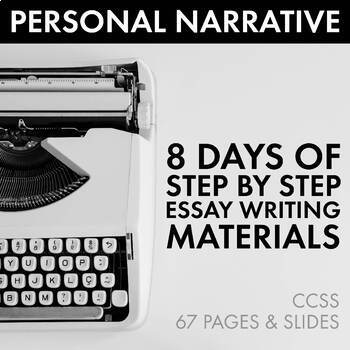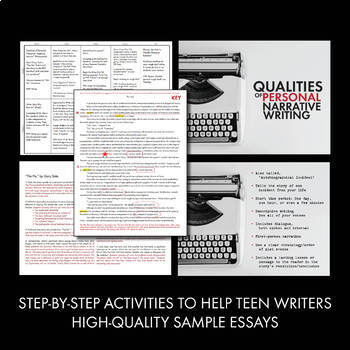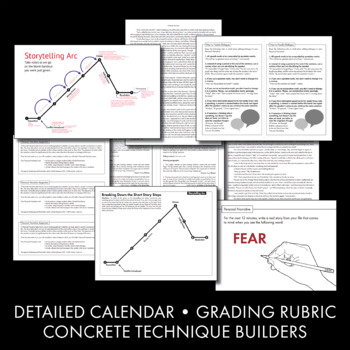Personal Narrative Essay, Autobiographical Incident Writing, Step-By-Step, CCSS
- Zip
What educators are saying
Description
Help your high school and advanced middle school students get creative with this eight-day Personal Narrative essay writing mini-unit. Featuring models of one professional and three exemplar student-written personal narrative essays, this bundle of step-by-step materials will inspire even reluctant students to put pen to paper. Activities/handouts featuring modern design elements and dynamic lecture materials will guide your students to craft their own meaningful autobiographical incident essays. Just print and teach!
This budget-priced bundle of essay writing materials includes:
• Day-by-day calendar with helpful tips and nightly homework assignments for students
• Opening lecture detailing the qualities of Personal Narrative (Autobiographical Incident) essay writing
• One-day lesson focusing on analysis of an excellent professional example of a Personal Narrative essay
• Essay Assignment handout, with clear expectations to help with students’ organization
• Examples of strong Personal Narratives sample essays to serve as clear models for your current students
• Topic Suggestions handout to help students find a good story from their lives to use with this assignment
• Quickwrite brainstorming topics to allow for unique topics for four separate classes, along with a note to the teacher
• Storytelling Arc Lecture link detailing the successful steps that are included by writers who build satisfying stories (includes both Prezi & Google Slides versions)
• Breaking Down the Story Steps handout to help students organize their Personal Narrative stories before they start to write the essay
• Show (Not Tell) Writing Assignment to help students practice descriptive writing techniques before they apply the skills to their own essays
• Sensory Questionnaire homework assignment to reinforce descriptive writing techniques
• How to Handle Dialogue handout to serve as a model for students as they add dialogue to their own Personal Narratives
• Write Like a Pro Lecture link detailing six specific techniques (participles, absolutes, appositives, adjectives shifted out of order, vivid verbs, and similes/metaphors) used by professional writers (includes both Prezi & Google Slides versions)
• Write Like a Pro worksheets/handout. Have students identify the techniques listed above and create their own sentences as they learn to use the techniques. Includes answer key.
• Applying Write Like a Pro, an activity where students identify the techniques used in yet another sample/model essay. Includes answer key.
• Peer Editing Sheet with detailed, step-by-step directions to allow students to help each other strengthen their writing
• Content Grading Rubric in both editable Word format and print-and-grade PDF format to help ease your grading load
The bundle includes 67 pages and slides. Pages are in PDF format. Slides are in both Prezi and Google Slides format.
Please note: Write Like a Pro is a lesson sold separately in my shop and included in my four-week Short Story bundle, which also features the Storytelling Arc Prezi. If you’ve already used the Short Story unit with your classes, you can skip those two lessons in this writing unit and just refer back to your earlier work. If you purchase either this Personal Narrative writing unit or the Short Story unit, there’s no need to purchase Write Like a Pro as a separate item. The materials are the same.
Need fun, attention-grabbing materials on How to Write an Argumentative Essay? Just click here.
NOTE: This item is also included in my English 9-10 full-year curriculum. If you already own the full-year download, please do not purchase this item here individually. If you’d like to receive this item plus everything else needed to teach 180 days of English 9 or English 10 at a deeply discounted price, click here to learn more about the full-year curriculum download.
Need more writing tools?
• Argument essay writing unit:
https://www.teacherspayteachers.com/Product/Argumentative-Essay-Writing-Argument-Writing-How-to-Guide-Topics-Rubric-CCSS-1630110
• Research – Blog-based approach to teach research writing: https://www.teacherspayteachers.com/Product/Research-Based-Writing-for-Teens-Use-Blog-Approach-to-Practice-Research-CCSS-2625300
• Literary Analysis essay writing unit:
Thanks for stopping by!
Cover image credit: Unsplash, Public domain





